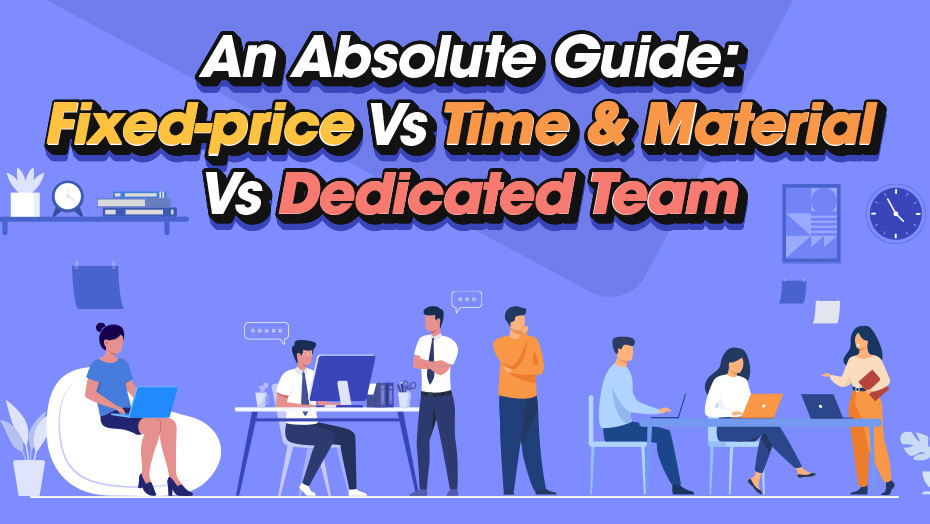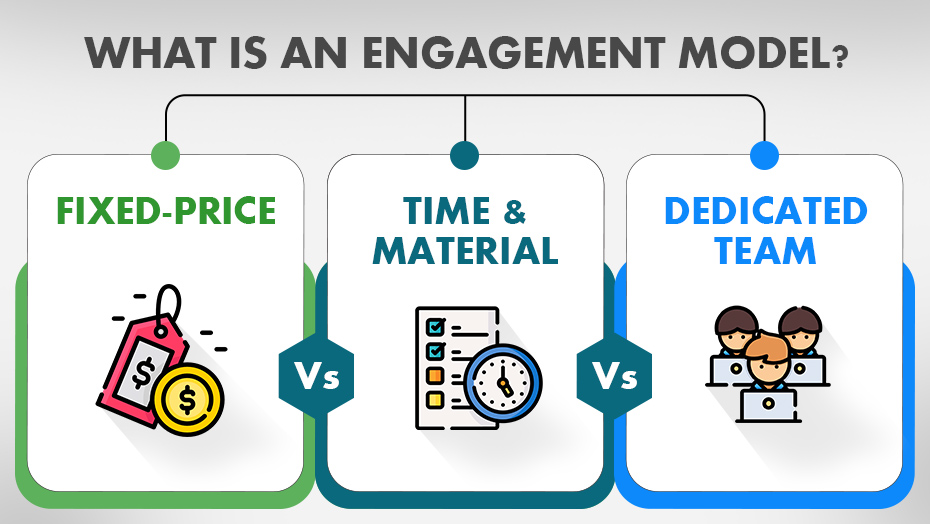
Fixed-Price Vs Time & Material Vs Dedicated Team : Which One Choose and Why?
on April 06, 2023
Selecting the engagement model is one of the most challenging tasks you must undertake before embarking on the project.
Secondly, don’t look for the best model available; choose an outsourcing model that works best for you.
The engagement model will not only help you build the entire project but will also be a subtle example of building your future projects exceptionally well.
So right from reevaluating your requirements to explaining them to the development company you are working with, and while taking a minor financial risk, there’s much to be done from your end.
The downsides of choosing the wrong model are many. It might lead to you losing your website visitors, running out of resources, or losing an ample amount of money.
In this write-up, we will discuss everything about these engagement models - Fixed-price, Time & Material & Dedicated Team so that you can arrive at an informed & realistic decision.

What Is an Engagement Model?
Building a relationship with clients is imperative for any company. Therefore, this engagement model forms a structure that decides how the association with your software development company can be successfully formed with the client.
The main goal of this model is to understand the client's wants, interests, and needs and show them accountability & ease in performing the project.
Your clients will choose a development model on the basis of different factors such as expertise, reputation, cost of the application, and more.
Let’s learn about the various types of engagement models. They are;
- Fixed-price model
- Time & Material
- Dedicated Team
Fixed Price Engagement Model
This model is the most sought-after solution where the development team has to deliver the project as per the fixed deadline decided by both parties.
Most clients choose the fixed price model for their projects as they do not have to pay additional charges other than the pre-decided price.
This model is especially recommended for small and mid-sized companies as their goals are generally realistic.
This process may sometimes be difficult for the software development team due to last-minute changes, which need to be compensated by the team if it hinders the decided price.
Such small errors can be avoided with a strong relationship with the client. But if you are building a new relationship, a small mistake in the development process can ruin your association with the client.
As a software development company, you must plan or schedule your project to articulate the cost, deadline, scope, and goals clearly.
It is advisable to talk to the client at every step of development. Also, you can create a comprehensive presentation where risks, the timeline for last-minute changes, or the additional expense of the project is determined.
When to use the Fixed-Price Engagement Model?
- While undertaking short-term projects or where the scope is limited.
- When there will be no changes during the development phase.
- When both the teams - in-house and external are well aware of each other’s working patterns, drawbacks, and credentials.
Advantages
- One of the best qualities of this model is its foregone conclusion. For instance, from the beginning, you can know the total expense for 2-3 months.
- The workflow of this model is simple & straightforward
- The requirements and specifications are pre-decided, giving the customers a clear idea of the project.
- The final cost is as per the budget.
Limitations
- If the client fails to communicate their requirements properly, some issues may arise in the project.
- The scope for flexibility is minimal due to the strict timeline.
- Any transformation in the development process can affect the total cost, which has to be borne by the service provider.
Time & Material Engagement Model
This model depends on the resources and the time consumed by the development team.
Here the client only pays for the total time required to complete the task, minus the additional time.
It is important to provide a dedicated project timeline and supervise the entire process.
When the requirements are specified, the work delivered to you will be faster. On the other hand, a gap in determining the timeline will result in more working hours and a number of issues.
As the global industry is witnessing changes in a short period of time, speed has become the success of the product.
A model like fixed-price often fails in this dynamic work environment. Therefore, we have the Time & Material model, where clients only pay for the efforts the development team gives.
If you are concerned about the money spent on the project, it is advisable to choose Time & Material model.
You can address the scope of the work and provide a dedicated budget; this way, the development company will only work as per the stated requirements.
If a company or a client fails to provide the specified requirements, they might have to pay an additional cost on a weekly, hourly, or daily basis.
When to Use Time & Material Model?
- When the requirements are ever-evolving or long-term.
- When you require flexibility in the workflow.
- Requirement of transparency between the team.
- When you have to deal with a complex project.
Advantages
- It provides flexibility in terms of work without budget constraints.
- The workflow of this model is simple & straightforward
- The working pattern becomes more straightforward with a negotiable budget and other flexibility.
- The budget has more space for iterations, resulting in a fruitful delivery.
Limitations
- With additional features & last-minute changes, the budget might increase.
- The client and the development team meetings become crucial, which may take enough time.
- The delay in the project and inefficiency can be witnessed due to the lack of a proper timeline.
Dedicated Team Engagement Model
This engagement model eradicates the loopholes of both systems.
The service provider will handle everything from recruitment, administrative assistance, and infrastructure to support.
They monitor the performance and ensure you have the right team to cater to the clients.
On top of that, they will follow corporate policies & culture development methodologies & more.
It is generally used for long-term projects where the specifications are unclear, or the scope is not pre-defined.
Sometimes clients cannot recruit employees with expertise in certain areas, so they hire a dedicated development team or other teams.
When you hire a dedicated outsourcing team, they provide high-quality and unique services without expanding the core team. This saves a lot of time, money & resources.
The client can interact with the dedicated team and control the project's progress.
More precise and transparent communication is possible between in-house and dedicated teams.
When to Use the Dedicated Team Engagement Model?
- When you require a dedicated team to accomplish more definite tasks.
- When the client requires uniqueness in the project.
- The requirements are pre-defined and coordinated between the teams.
- For dealing with overseas projects or working with an offshore development company.
Advantages
- This model's flexibility is great for both clients and the development team.
- The customers can review the real-time progress of the project.
- Resources are not wasted due to total control.
- You have access to some of the great minds who have years of experience & expertise in working on multiple projects.
Limitations
- The planning process can be prolonged, affecting the actual task
- The two teams might have different opinions, which might delay the project.
- More time is invested in negotiation, communication, and development part.
- This model fails to provide efficiency when the project is short-term.
Comparison of these Outsourcing Models
Let’s compare these models and find out which best suits your business needs;
Fixed Price VS Dedicated Team - An Overview
It is obvious that you get confused between the models as they all come with certain profitable perks for your business.
As stated above, when you are working on a short-term project, make sure you choose a fixed-price development model.
Moreover, when you choose a fixed-price model, the requirements should be pre-defined, avoiding any kind of miscommunication at the end.
If your project is big and needs special assistance, a dedicated development team model would be a great choice.
In this model, you have tons of flexibility; there is a scope for ideation, changes, and the best creative work by the development team.
Time and Materials VS Fixed Price - An Overview
If you are unsure about the kind of project you are building, it is advisable to go with Time and Material model.
When you do not want to manage the financial risk, go with a fixed price. If you have the time to access the development phase, choose the latter. With quality work, it will also save time & resources.
How crucial is flexibility for you? If you can devote some time to the project or oversee it for 1-2 weeks, choose Time & Material. If you are highly dependent on the software development company for the project's success, opt for a fixed-price model.
How to Choose a Suitable Engagement Model?
Evaluate your organization's technical expertise and how far you want to reach.
Ask questions like do you want a dedicated team, or do you want to hire some experts? Do you have a strong budget to back your development project?
Each model comes with a set of risks and outstanding benefits. Choosing one from fixed VS Time & Material VS Dedicated Team is indeed overwhelming. It highly depends on the nature & scope of your project.
The next step is to consider factors that are super important for you to make the right decision.
- Budget
- Flexibility
- Scope of work
- Expertise
- Location
- Goals
- Communication
From these mega engagement models, we recommend you opt for the Dedicated team model because of its flexibility, affordability, and functionalities.
You also get to work with some of the great minds across the world; this way, productivity will be enhanced, resources will be used in the best possible way, and delay in the project might be avoided.
Still not sure which engagement model is right for your company? Connect with us to find the best staffing solutions, increase productivity, and get quick results.
We will provide a demo session, explaining each model and also assist you in finding the right one.
 For a better view on
Talent By Netclues,
For a better view on
Talent By Netclues, 



